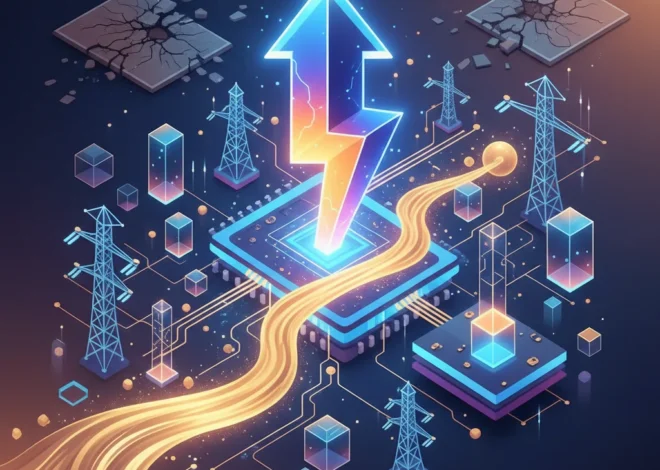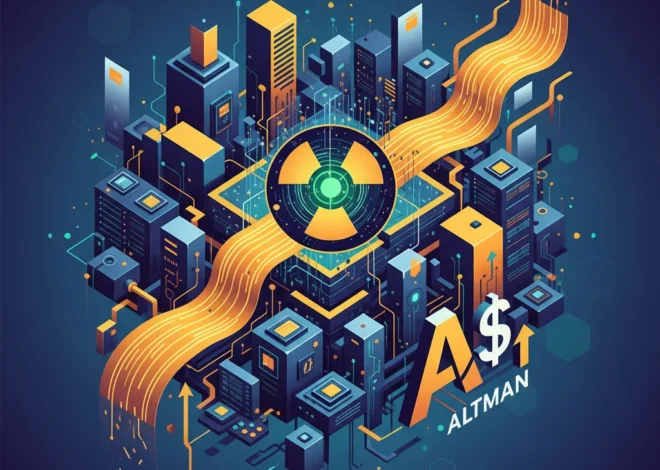
The Hidden Engine of AI: How Your Retirement Fund Is Quietly Building Silicon Valley’s Future
We’re living through an explosion. Every week, a new generative AI model shatters previous benchmarks, and every company, from tiny startups to global giants, is scrambling to integrate artificial intelligence into its DNA. We see the flashy demos, the mind-bending art, and the promise of a future powered by intelligent software. But behind the curtain of this digital revolution lies a very physical, very expensive reality: the data center.
The AI dream is built on mountains of silicon and miles of fiber optic cables housed in colossal, power-hungry buildings. The demand for computational power is insatiable, driving a construction and hardware boom of unprecedented scale. This begs a critical question: Who is footing the bill for this multi-trillion-dollar build-out? If you think it’s just venture capitalists in Patagonia vests, think again. The answer is far closer to home. In fact, it might be you.
A significant portion of the capital flooding into AI infrastructure isn’t coming from traditional equity investments. Instead, it’s being financed by a complex, often opaque world of debt—debt that is packaged, sold, and ultimately lands in the investment portfolios that line millions of retirement accounts, pension funds, and insurance policies. Your nest egg is, in all likelihood, one of the silent investors in the AI gold rush.
From Weightless Code to Heavy Metal
For decades, the gospel of Silicon Valley was the capital-light startup. The ideal venture was a SaaS platform or a mobile app—infinitely scalable with minimal physical footprint. The biggest expense was talent, not machinery. The cloud, in its earlier form, abstracted away the need for hardware, allowing a handful of developers to build empires from their laptops.
The AI era has flipped that script. Modern machine learning, especially large language models (LLMs), requires a staggering amount of specialized hardware. Companies like Nvidia have become kingmakers, with their GPUs acting as the essential picks and shovels of the AI gold rush. To train a cutting-edge model, you need thousands of these chips working in concert, housed in highly specialized data centers with advanced cooling and networking.
This is no longer a game of “weightless” bits and bytes. This is a game of heavy industry. According to one estimate, the AI industry could consume up to 134 terawatt-hours of electricity annually, more than a country like Argentina. Building and equipping the data centers to handle this demand requires billions upon billions of dollars in upfront capital. Venture capital, which thrives on high-risk, high-reward equity bets, is not structured to finance this kind of predictable, utility-like infrastructure. So, a different kind of money has stepped in.
Beyond the Billions: How Elon Musk's "Frugal" Lifestyle Fuels a Revolution in AI and Tech
Meet the New Wall Street of AI: Asset-Backed Securities
Enter the world of private credit and structured finance. While the terms sound intimidating, the concept is relatively straightforward. Instead of a VC giving a startup money in exchange for a slice of the company (equity), a data center operator or a cloud provider will finance its hardware through debt.
Here’s a simplified look at the process:
- A company needs $500 million worth of servers to meet AI demand.
- It secures a loan or a lease agreement to acquire this hardware. This agreement generates a predictable stream of future payments.
- A financial firm then bundles this loan—along with hundreds of other similar ones—into a package.
- This package is sliced up into bonds, known as Asset-Backed Securities (ABS), and sold to large institutional investors.
The “asset” backing these securities is the physical hardware (the servers) and, more importantly, the contracts from cloud customers who pay to use that hardware. For investors like pension funds, this is an attractive proposition. It’s a way to get exposure to the booming AI sector without the wild volatility of a startup stock. They are essentially buying a steady, predictable income stream, much like a landlord collects rent.
This financing mechanism is now a cornerstone of the AI economy. In 2023 alone, data center companies raised $41.4 billion in debt, a significant portion of which was likely funneled into these kinds of securities. This intricate financial plumbing connects the world’s largest pools of capital directly to the server racks powering the next wave of innovation.
To understand the shift, it’s helpful to compare the old model with the new. Below is a breakdown of how traditional venture capital differs from the debt financing now powering AI infrastructure.
| Financing Feature | Traditional VC (Equity) | Infrastructure Debt (ABS) |
|---|---|---|
| What is being funded? | Company growth, R&D, marketing, hiring | Physical assets like servers, networking gear, and data center construction |
| Who provides the capital? | Venture capital funds, angel investors | Pension funds, insurance companies, large asset managers |
| What do investors get? | Ownership stake (equity) in the company | A contractual right to a steady stream of interest payments (income) |
| Risk Profile | High risk, high reward (binary outcomes) | Lower risk, predictable returns (backed by physical collateral) |
| Investor Goal | Massive capital appreciation (100x return) | Stable, reliable yield (5-10% annual return) |
The key question for AI-backed debt is: what is the systemic risk? The “collateral” here is highly specialized computer hardware that depreciates rapidly and whose value is entirely dependent on sustained, stratospheric demand for AI services. If there’s an “AI winter” or if a new, more efficient programming paradigm emerges that requires different hardware, today’s top-of-the-line servers could become very expensive paperweights. While the risk is currently seen as low, the sheer scale of this debt market means that even a small downturn in the AI sector could send unexpected shockwaves through the broader financial system, potentially impacting the very retirement funds that are fueling the boom. It’s a symbiotic relationship that is incredibly powerful in a bull market, but its resilience in a downturn has yet to be tested.
Why This Matters to You
This financial machinery might seem distant, but its implications are direct and personal, whether you’re a developer, a founder, or just someone with a retirement plan.
For Developers and Tech Professionals
The cost and availability of the cloud computing resources you use every day are directly influenced by these capital markets. The ability for providers like AWS, Google Cloud, and Azure (and their emerging competitors) to rapidly scale is dependent on their access to this debt financing. Furthermore, the immense focus on hardware-level automation and efficiency is driven by the need to guarantee returns to bondholders. Your work in optimizing code and building efficient machine learning models has a direct impact on the financial viability of these massive investments.
For Founders and Entrepreneurs
This trend signals a bifurcation in the tech landscape. While software-centric SaaS companies will continue to rely on traditional VC, founders of startups requiring heavy computation or physical infrastructure now have alternative financing routes. It also means that the barrier to entry for competing at the foundational model level is becoming insurmountably high, controlled by those with access to Wall Street’s deepest pockets. Your competitive advantage will increasingly lie in clever application and software-layer innovation, not in raw computational power.
AI's Dirty Secret: Why Your Company's Biggest Hurdle Isn't the Algorithm
For the Everyday Investor
Your investment portfolio is now an active participant in the AI revolution. Through your pension, 401(k), or even simple index funds, you are providing the capital that builds data centers. This has been a fantastic investment so far. However, it’s a reminder that your financial future is interwoven with the boom-and-bust cycles of the tech industry in ways that are not always obvious. The stability of your retirement is now partially dependent on the world’s continued obsession with generative AI. This also brings up crucial considerations for industries like cybersecurity, as these data centers represent incredibly high-value, centralized targets that must be protected to secure these investments. As the FT article notes, this is a market where “everyone from Blackstone to BlackRock is now a player (source).”
The Great AI Power Play: Is Big Tech Forcing the EU to Back Down on Its Landmark AI Act?
The Foundation of the Future
The AI revolution is not just a story of brilliant code and disruptive algorithms. It’s also a story of finance, infrastructure, and a quiet, seismic shift in how the digital world is built and paid for. The move from equity to debt for funding the industry’s backbone is a sign of its maturation, transforming the wild frontier of technology into something resembling a global utility.
The next time you prompt a chatbot or use an AI-powered tool, remember the vast, invisible financial architecture humming in the background. It’s a system that connects your savings to a server rack in Virginia, a pension fund in Tokyo to a GPU in Oregon. We are all stakeholders in this grand experiment, providing the financial bedrock for the age of artificial intelligence. The question is no longer who is building the future, but whether the foundation we’re laying is as solid as it appears.


